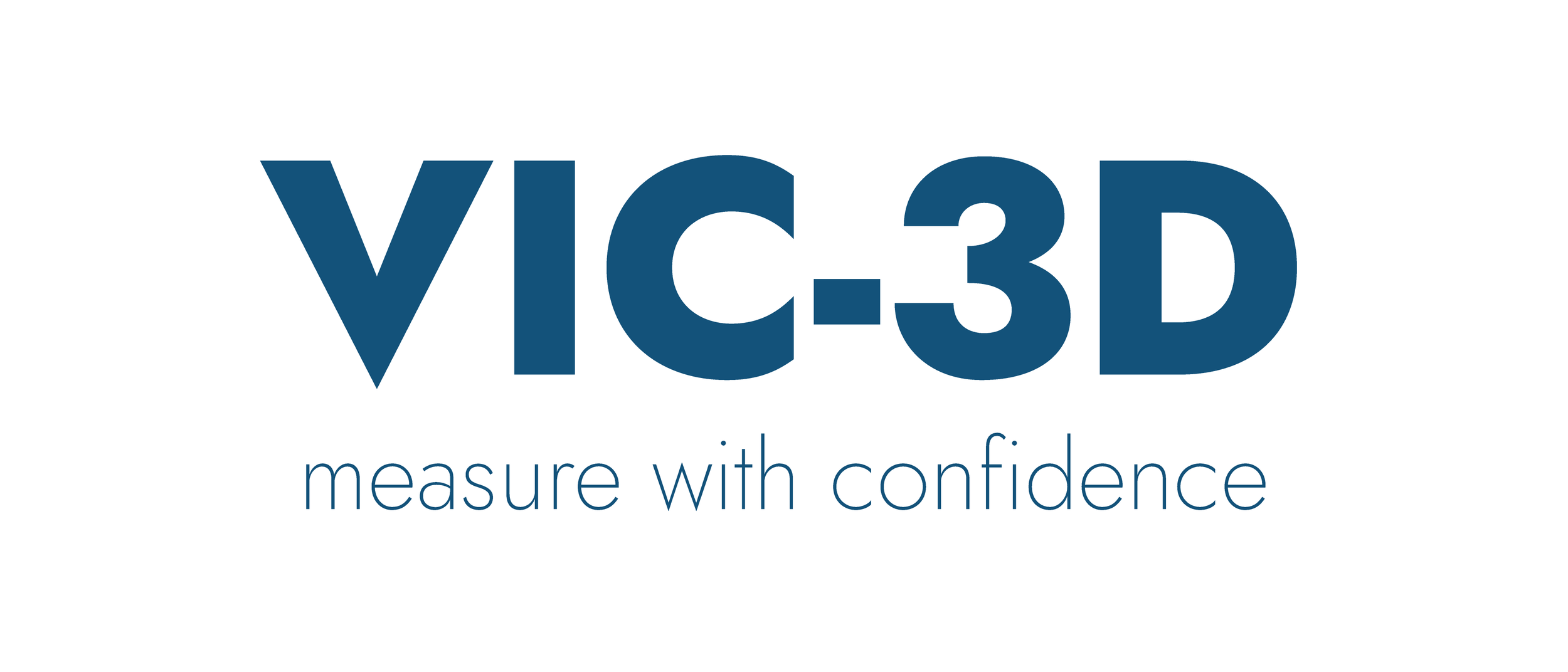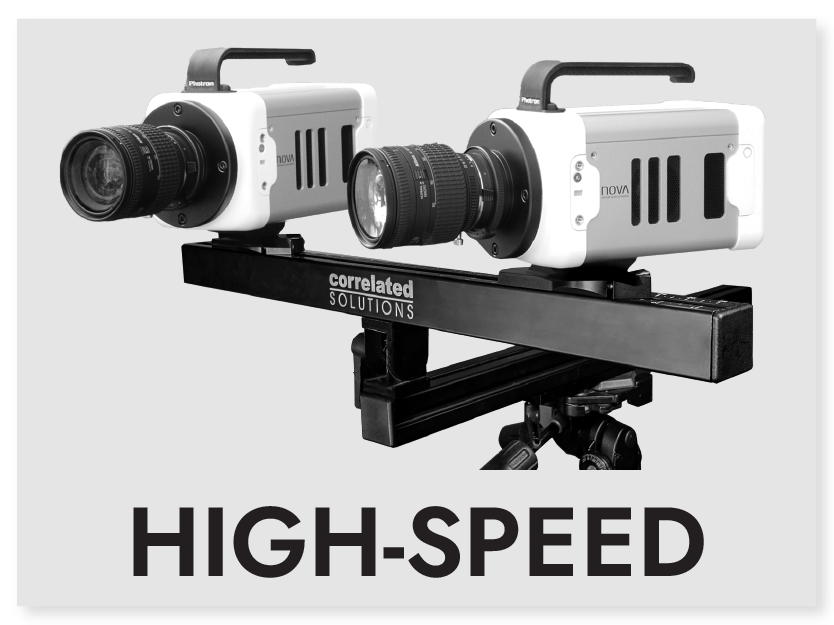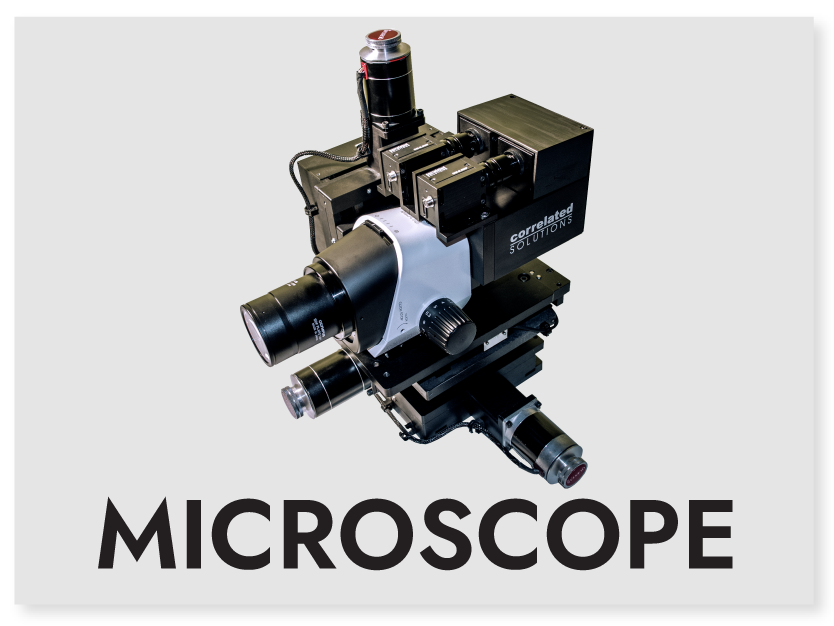

Non-Contact, Full-Field Strain & Deformation Measurement System
The VIC-3D system is a powerful turnkey solution for measuring and visualizing full-field, three-dimensional shape, displacement, and strain based on the principle of digital image correlation. Using this method, 3D displacements and strains can be obtained at every pixel on the specimen’s surface. All systems are customized and are available for a wide range of size scales for quasi-static and dynamic events. All systems are turnkey and include all necessary software, hardware, training, and technical support to ensure the system operates exactly as expected.
VIC-3D measures arbitrary displacements down to nanometer resolution (dependent upon the field of view of the setup), and strains from 50 microstrain to 2500% and above are possible with 10-50 microstrain or better strain resolution. Specimen sizes ranging from < 1 mm to > 100 m are possible, and dynamic events can be captured up to a rate of 5,000,000 fps (frames per second). System setup is simple and only requires a quick calibration procedure and an applied random speckle pattern. No special illumination or lasers are required, and there is no contact with the specimen during testing. In summary…if we can see it, we can measure it.
VIC-3D 10
NOW AVAILABLE!
“Using the ability to stitch data with the VIC-3D multi-camera system allowed us to significantly increase the performance of the Digital Imaging Elasto-Tomography (DIET) method for the detection of breast cancer. The full-field 360° integrated data has allowed us to move from a few hundred data points to tens of thousands of data points for each data file of the test.”
Dr. Elijah Van Houten, Mechanical Engineering Department, University of Sherbrooke
System Highlights
Check out this video featuring Dr. Michael Sutton explaining how DIC is compared to FEA using VIC-3D.
Our DIC systems are designed with the user experience as the primary focus. They are simple to set-up, calibrate, and operate. A selection of the most important features of the VIC-3D system is listed below:
Compare FEA and DIC data using VIC-3D: Among the new features of the powerful VIC-3D software is the ability to quickly and accurately compare finite element predictions and digital image correlation measurements. This update will establish a soon-to-be essential workflow for engineers in many fields.
Versatility and Convenience: With our extremely portable VIC systems, data can be collected in a wide range of settings with ease. Results can be processed on the spot or data can be exported for analysis in the convenience of your office. Processing can also be done on any Windows PC with flexible floating licenses or network licenses.
Software Integration and Ease of Use: The VIC Software Suite is extremely easy to use and provides a user-friendly interface consistent throughout all applications. Powerful tools include report generation, animation creator, python scripting, copy & paste across Windows applications, and flexible and complete data export features.
Performance and Accuracy: The VIC image correlation algorithms are accurate and extremely fast. In fact, industry-leading real-time processing can be achieved using a modern consumer multi-core processor. Our systems can process up to 1,000,000 points per second using a single 32-core CPU, which is years ahead of the competition. This saves valuable time and money, especially for high-resolution image processing or when processing thousands of images for vibration analysis.
Experience, Knowledge, Technical Support: The Correlated Solutions support team includes engineers with a combined experience of over 200 years. This also includes well-known authors who have developed the technology from the ground up. Our team develops the software, designs hardware components, integrates all hardware, and tests all systems to ensure high quality while including the very best technical support from the manufacturer. The Correlated Solutions team has the experience to tackle even the most challenging applications to help get the most out of every VIC-3D system.
Custom Python Scripting: VICPy is Correlated Solutions’ free library of scripts written in the Python programming language. Python scripting can be used to create highly customized solutions by allowing users to manipulate VIC-3D data files. This is an exciting and empowering way to achieve repeatable results and is especially useful for batch processing. Custom scripts may also be developed upon request, and sometimes at no cost (evaluated on a case-by-case basis).
Specialized VIC-3D Systems
Data Visualization with iris
The powerful iris graphics engine brings a host of new functionality all from within the already versatile VIC-3D software. Some of the exciting new features include:
Import finite element data for visualization and comparison to measurement data into new graphics framework
Display synchronized analog data values alongside data plots
Create life-like animations using integrated adaptive motion blurring for fast-moving objects
Animate object position, scale, opacity, rotation, and more with an all-new user-friendly interface
View speckle images on 3D plots
View high-resolution isolines on 2D and 3D plots with scalable fonts
Create high-resolution, publication-ready plots in PDF and ultra-high-definition video formats (from 720p to 4K)
Create high-quality videos using a multi-threaded rendering engine
Edit labels with Unicode support
Standard Quasi-Static VIC-3D System
One of the most common configurations of the VIC-3D system is for quasi-static applications for measuring deformation and strain on specimens under ‘slow’ loading. Whether performing simple tensile tests, compression tests or applying large loads to structures, this system has the power to deliver accurate results with high spatial resolution. Because quasi-static applications do not require very fast acquisition rates, these systems benefit from utilizing ultra-high-resolution digital cameras for maximum spatial resolution. VIC-3D systems for quasi-static applications are offered in a wide range of resolution and frame rate combinations starting at 2.3 MP (140 Hz) and up to 45 MP (10 Hz) with many options in between















